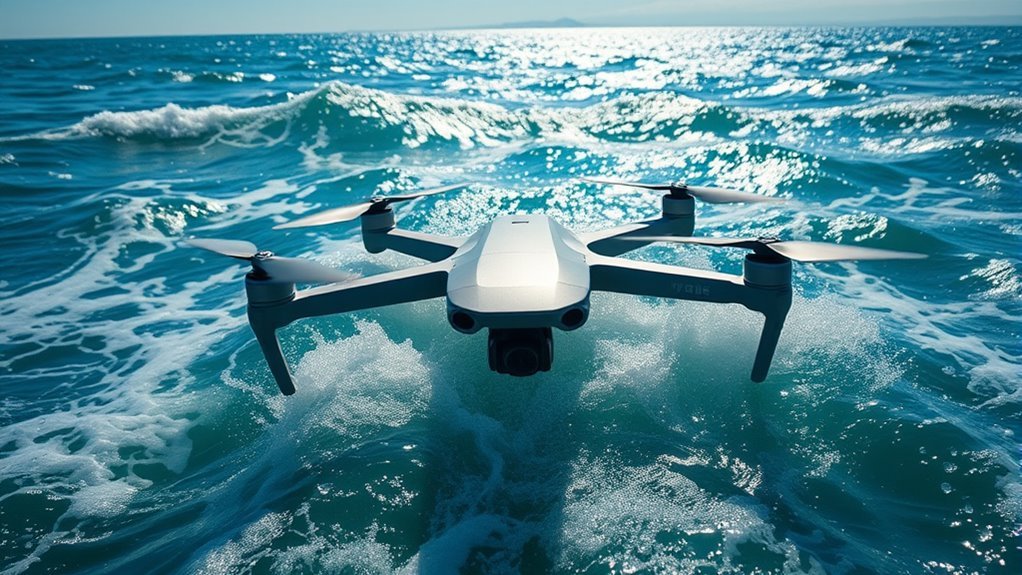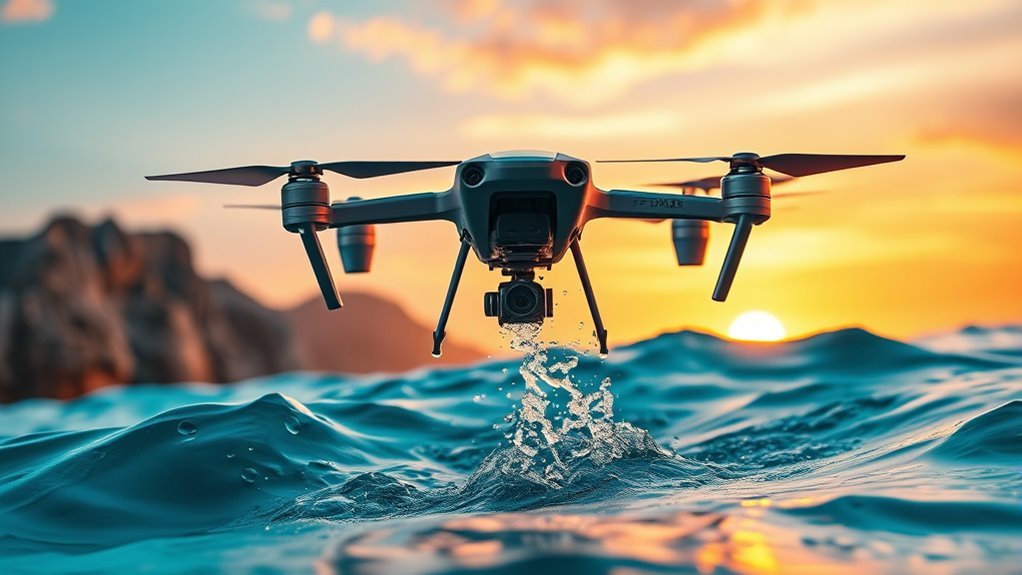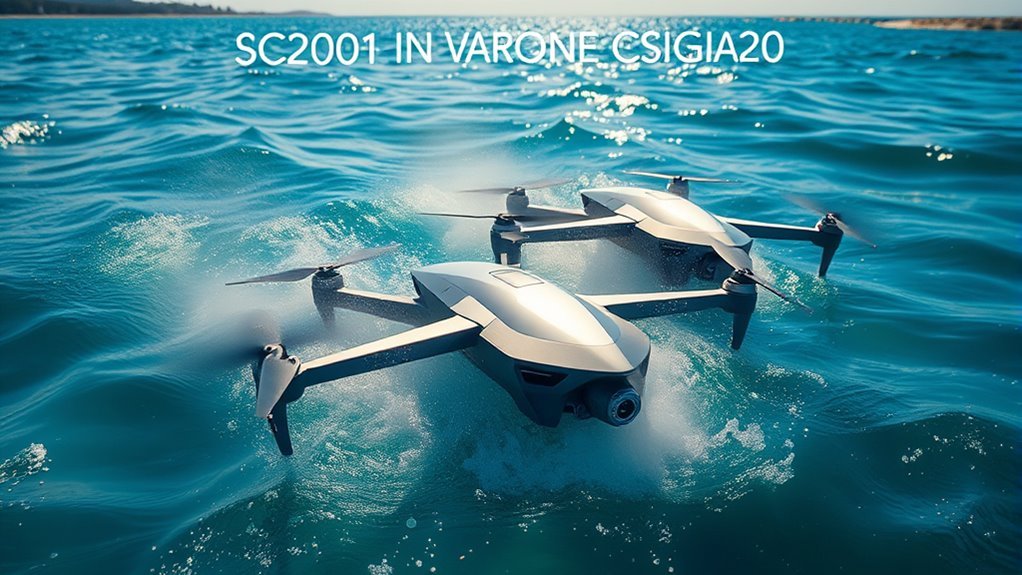Drones are revolutionizing oceanic operations by enhancing marine research, improving search and rescue efficiency, and monitoring environmental changes. They support aquaculture by tracking fish populations and detecting diseases early. In infrastructure inspection, drones minimize downtime and reduce risks to personnel. Their advanced technology enables real-time data collection and autonomous navigation, making them invaluable in disaster response. These capabilities are just the tip of the iceberg; there’s more to uncover about drones’ impact on our oceans.
Enhanced Marine Research Capabilities

As researchers dive deeper into the mysteries of the ocean, drones are transforming marine research capabilities by providing unprecedented access to hard-to-reach environments. These advanced tools facilitate oceanographic studies, allowing you to collect data more efficiently than ever before. Equipped with high-resolution cameras and sensors, drones excel in underwater mapping, offering detailed insights into seafloor topography and marine habitats. You can monitor environmental changes, assess biodiversity, and track marine life movements with precision. The ability to deploy drones in challenging conditions means you’re not limited by traditional research methods. This freedom to explore remote areas enhances your understanding of ocean ecosystems, ultimately contributing to better conservation efforts and sustainable practices. Embrace these technological advancements for a brighter future in marine research.
Improved Search and Rescue Operations

While traditional search and rescue operations often rely on time-consuming methods, the integration of drones is revolutionizing how responders locate and assist those in distress. With advanced technology at their disposal, these drones enhance efficiency and accuracy in critical situations.
The integration of drones is transforming search and rescue operations, making them faster and more precise in critical situations.
Consider the following benefits:
- Rapid Deployment: Drones can be launched quickly, covering vast ocean areas in a fraction of the time.
- Advanced Oceanic Navigation Systems: They utilize real-time mapping to pinpoint search areas effectively.
- Underwater Communication Tools: Drones can relay essential information from submerged areas back to responders.
- Live Video Feed: Real-time visuals allow for immediate assessment of the situation, enabling quicker decision-making. Additionally, drones offer real-time aerial surveillance capabilities that enhance situational awareness for rescuers.
This tech not only saves time but could also save lives, demonstrating the future of rescue operations. Drones can significantly improve emergency response efforts by ensuring timely delivery of essential supplies to rescue teams in remote locations.
Environmental Monitoring and Protection

Drones are revolutionizing how you monitor marine ecosystems and protect the environment. With advanced sensors for pollution detection and capabilities for surveying marine life, these aerial units play an essential role in habitat restoration efforts. By leveraging drone technology, you’re not just observing changes; you’re actively contributing to the health of our oceans. Additionally, the integration of real-time data analysis enhances your ability to respond swiftly to environmental threats, ensuring timely interventions that safeguard marine habitats. Furthermore, high-resolution imagery captured by these drones provides critical insights into the conditions of marine environments, enabling more effective conservation strategies.
Marine Life Surveillance
Although the ocean’s vastness often conceals its inhabitants, innovative technologies like drones are revolutionizing marine life surveillance. These aerial devices offer you a unique vantage point to monitor and protect delicate ecosystems. With advanced capabilities, drones can gather critical data on:
- Fish population dynamics, revealing trends in species abundance
- Underwater behavior analysis, observing interactions in real time
- Habitat mapping, identifying critical areas for conservation efforts
- Environmental changes, tracking shifts in temperature and salinity
Pollution Detection Technology
As environmental concerns grow, the integration of pollution detection technology into drone systems offers an efficient solution for monitoring ocean health. These drones, equipped with advanced pollution sensors, can perform ocean sampling with remarkable precision. This technology allows you to gather real-time data on contaminants, enabling quicker responses to pollution events. By harnessing drone capabilities, you can cover vast marine areas that traditional methods struggle to monitor. The ability to analyze water quality from above not only enhances your understanding of ocean ecosystems but also empowers you to advocate for cleaner waters. With these innovations, you’re taking a significant step towards preserving marine environments, ensuring future generations can also enjoy the freedom of healthy oceans.
Habitat Restoration Efforts
With the growing capabilities of pollution detection technology in drones, efforts to restore marine habitats are becoming more effective and targeted. You’ll find that drones play an essential role in enhancing ocean biodiversity and facilitating coral restoration. Here’s how they’re making an impact:
- Mapping vulnerable habitats to identify areas needing urgent attention.
- Monitoring water quality to guarantee ideal conditions for marine life.
- Guiding coral restoration efforts by deploying materials that encourage growth.
- Tracking wildlife populations to assess the health of ecosystems.
These applications not only empower conservationists but also enhance your connection to the ocean. By leveraging drone technology, you’re part of a movement that champions environmental protection and the revival of our planet’s precious marine resources.
Efficient Infrastructure Inspection
When it comes to infrastructure inspection, using drones can greatly enhance safety protocols by reducing the need for personnel in hazardous environments. These aerial devices provide a cost-effective solution, allowing for quicker assessments without sacrificing quality. By leveraging drone technology, you can streamline inspections and minimize downtime, ultimately saving resources. Additionally, advanced sensor capabilities in drones enable detailed data collection that improves the accuracy of inspections. Moreover, the integration of real-time aerial data processing enhances decision-making and operational efficiency during these assessments.
Enhanced Safety Protocols
While traditional methods of infrastructure inspection often pose risks to personnel and can be time-consuming, the integration of drones has revolutionized safety protocols. With drones, you can guarantee regulatory compliance while enhancing safety training for your teams.
Here’s how drones improve safety during inspections:
- Minimized Risk: Inspect hard-to-reach areas without exposing workers to danger.
- Real-Time Data: Get immediate feedback, allowing for quick decision-making.
- Consistent Monitoring: Conduct regular inspections without the need for extensive manpower.
- Environmental Awareness: Assess structures in various conditions, guaranteeing thorough evaluations.
Cost-Effective Solutions
The shift to drone technology not only enhances safety but also offers significant cost savings for infrastructure inspection. By utilizing drones, you can achieve affordable innovation, reducing the need for expensive scaffolding and manual labor. This technology allows for quick, thorough assessments of structures like bridges and pipelines, minimizing downtime and maximizing efficiency. Drones capture high-resolution images and data, enabling you to identify issues early and prioritize repairs, which leads to sustainable solutions. Plus, they can operate in hard-to-reach areas, saving time and resources. Embracing these advanced tools means you’re not just cutting costs; you’re also promoting a more responsible approach to infrastructure management, giving you the freedom to focus on what truly matters—keeping your assets safe and functional.
Support for Aquaculture and Fisheries
As technology advances, drones are proving to be indispensable tools in supporting aquaculture and fisheries. These flying marvels help promote sustainable practices while ensuring the health of fish populations. Here’s how they contribute:
- Monitoring: Drones can survey large areas quickly, tracking fish behavior and identifying potential overpopulation.
- Data Collection: They gather essential information on water quality, contributing to better management of aquatic ecosystems.
- Feeding: Automated drone systems can deliver food efficiently, reducing waste and ensuring fish receive proper nutrition.
- Disease Detection: Early detection of disease outbreaks becomes easier, allowing for timely interventions that protect fish populations.
With drones, you’re not just enhancing productivity; you’re also fostering a sustainable future for our oceans.
Disaster Response and Recovery
When disaster strikes, drones can play a pivotal role in response and recovery efforts, offering rapid assessments and real-time data that are essential for effective management. These unmanned aerial vehicles enhance crisis management by quickly surveying affected areas, identifying hazards, and locating survivors. With their ability to reach remote or inaccessible locations, drones streamline resource allocation, ensuring that help gets where it’s needed most, faster. They can also be equipped with thermal imaging and advanced sensors to detect heat signatures or chemical spills, providing vital information during emergencies. By integrating drones into disaster strategies, organizations can make informed decisions, optimize response times, and ultimately save lives, empowering communities to reclaim their freedom and rebuild after calamities. Additionally, their advanced obstacle avoidance capabilities maintain mission integrity without constant oversight, further enhancing operational efficiency. Drones equipped with multi-spectral imaging can detect hidden details that are crucial for assessing disaster impacts and ensuring effective resource deployment.
Advancements in Technology and Autonomy
While advancements in technology and autonomy continue to redefine the capabilities of drones, their potential applications are becoming increasingly sophisticated. With the integration of artificial intelligence and autonomous navigation, these aerial vehicles are transforming how we explore and interact with our world.
- Real-time data collection for environmental monitoring
- Search and rescue missions in hard-to-reach areas
- Underwater exploration with minimal human intervention
- Surveillance and reconnaissance in unpredictable conditions
These innovations empower you to harness the full potential of drones, offering unprecedented freedom in various sectors. As technology evolves, the possibilities for autonomous drones emerging from the ocean are boundless, paving the way for a future where exploration and safety go hand in hand. Moreover, AI-enhanced obstacle avoidance features ensure that drones can navigate complex environments safely and effectively. Additionally, the use of real-time data processing enables drones to adapt to changing conditions on the fly, significantly improving mission outcomes.
Frequently Asked Questions
How Do Drones Operate Underwater and on the Ocean Surface?
Did you know that about 80% of the ocean remains unexplored? Drones operate underwater using advanced sensors and marine navigation systems, enabling them to gather data while seamlessly shifting between depths and the ocean surface.
What Are the Costs Associated With Deploying Ocean Drones?
When deploying ocean drones, you’ll face significant deployment expenses and operational challenges. These include maintenance costs, battery replacements, and potential damage from harsh conditions, all of which can impact your overall mission budget and efficiency.
Can Drones Withstand Harsh Oceanic Weather Conditions?
You’d think drones couldn’t handle ocean storms, but they’re built with remarkable ocean resilience and weather durability. These innovations guarantee they bravely navigate harsh conditions, pushing boundaries and bringing freedom to our explorations.
What Are the Privacy Concerns Related to Marine Drones?
When considering marine surveillance, you might worry about privacy. Drones collecting data can inadvertently capture personal activities, raising concerns over unauthorized monitoring. Balancing technological advancements with individual freedoms is essential to guarantee privacy remains protected.
How Are Drones Powered During Long Ocean Missions?
How do drones sustain energy on long ocean missions? They often utilize advanced battery technology paired with solar charging systems, allowing them to harness sunlight for extended operations, giving you a more autonomous and efficient experience.

